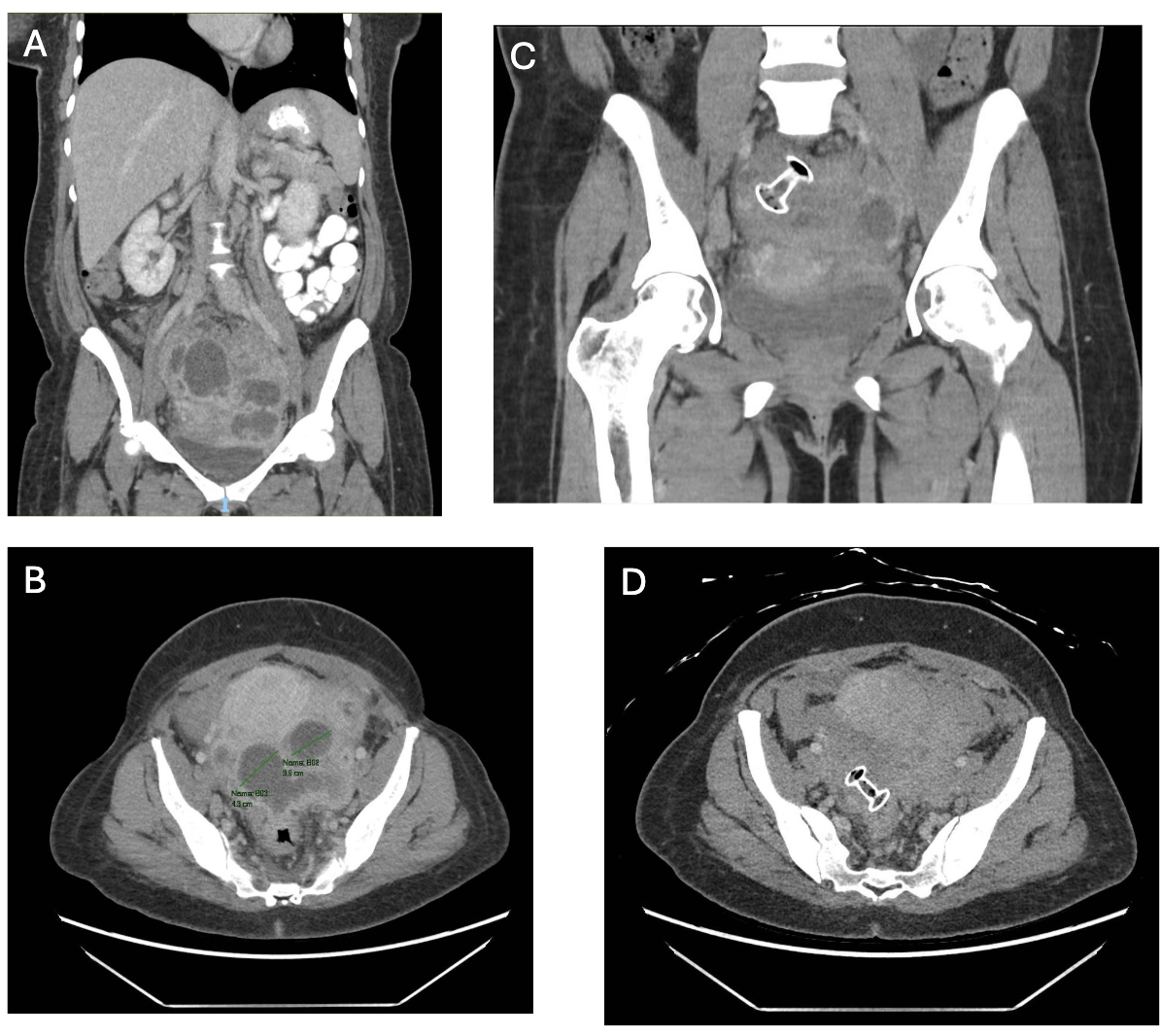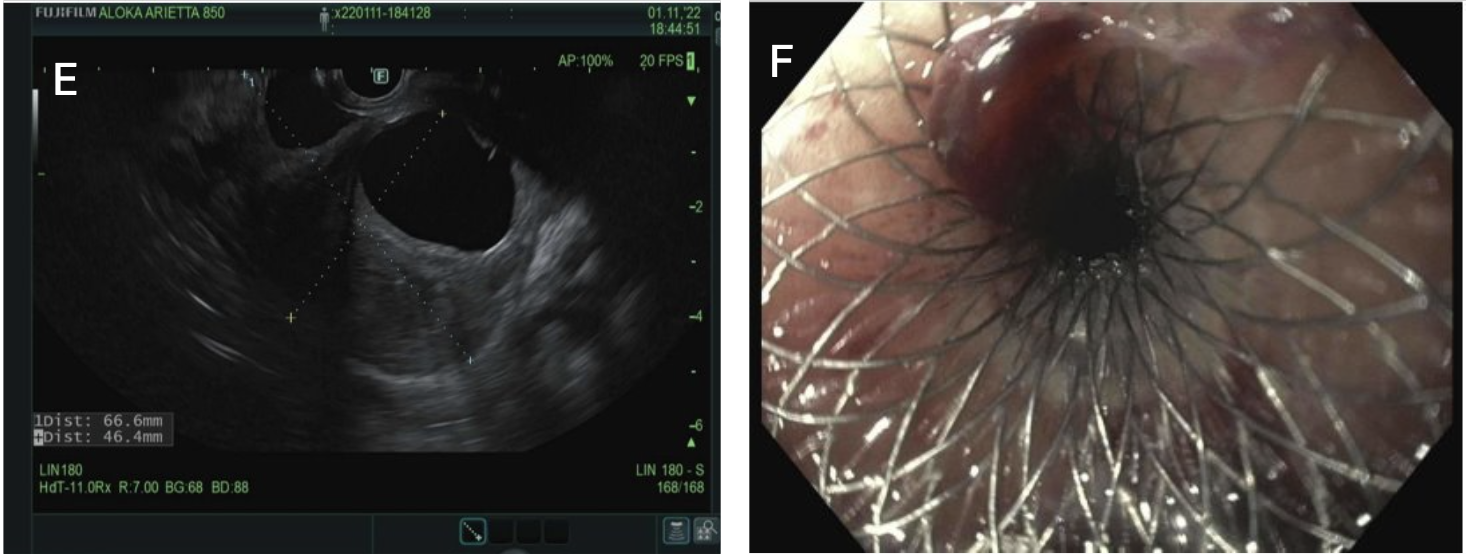Tuesday Poster Session
Category: Interventional Endoscopy
P5743 - A Case of Tubo-Ovarian Abscess Requiring Lumen-Apposing Stent for Minimally Invasive Drainage
Tuesday, October 28, 2025
10:30 AM - 4:00 PM PDT
Location: Exhibit Hall

Bishoy Gad, MD (he/him/his)
Montefiore Medical Center
Bronx, NY
Presenting Author(s)
Award: ACG Presidential Poster Award
Bishoy Gad, MD, Nicholas Costable, MD, Sammy Ho, MD, FACG
Montefiore Medical Center, Bronx, NY
Introduction: Tubo-ovarian abscess (TOA) is a severe complication of pelvic inflammatory disease (PID) and gynecological surgeries. The prevalence of TOA due to in vitro fertilization (IVF) is reported to be less than 1%. Historically, surgery and image-guided drainage have been the preferred modalities of source control. However, these techniques are limited by the location of the abscess and have variable rates of clinical success. Techniques such as endoscopic ultrasound (EUS) and lumen-apposing stent (LAMS) insertion have only been reported in one case report, but are a promising adjunct to surgical or image-guided procedures. We present a case of EUS-guided LAMS drainage of a complex TOA following embryo transfer during IVF.
Case Description/
Methods: A 44-year-old female with a history of fibroids, abdominal myomectomy, and lysis of adhesions presented with fevers, chills, and abdominal pain and was found to have bilateral TOA two weeks after an embryo transfer. The left TOA was 9 cm, and the right was 13 cm. She underwent IR-guided drainage of the right and left abscesses one week apart and was discharged on antibiotics. She then presented again with LLQ pain, WBC 16, and tachycardia, concerning for ongoing TOA. The patient underwent diagnostic laparoscopy, which revealed significant adhesions with the sigmoid colon, and the washout was terminated due to the risk of bowel injury. After multiple attempts at source control, the patient underwent a rectal EUS, and a 15 mm x 10 mm LAMS was placed in a large perirectal collection with successful outflow of purulent fluid. Repeat flexible sigmoidoscopy revealed a patent LAMS with healthy granulation tissue and no ongoing purulence or sign of infection. The LAMS was removed, and follow-up imaging demonstrated resolution of the abscesses.
Discussion: Bilateral TOA is an exceedingly rare complication of IVF. This patient's failed imaging-guided interventions and prolonged antibiotic courses were inadequate for source control of the TOAs, as well as a complex surgical approach that had to be terminated. This case demonstrates the versatility of EUS and other endoscopic techniques for the management of intraabdominal pathology. There is only one documented case of EUS and LAMS for a TOA, however, it diagnosed PID as the etiology. This case demonstrates how interventional gastroenterology plays a key role in a multi-disciplinary team for intra-abdominal and pelvic pathologies and should be considered in the initial management of pelvic abscesses requiring drainage.

Figure: A,B: CT Abdomen Pelvis revealing Pelvic Abscesses prior to LAMS drainage
C,D: CT Abdomen Pelvis revealing collapsed Pelvic abscesses after LAMS placement

Figure: E: Endoscopic Ultrasound with Abscess
F: Successful LAMS Placement for Peri-Rectal Abscess
Disclosures:
Bishoy Gad indicated no relevant financial relationships.
Nicholas Costable indicated no relevant financial relationships.
Sammy Ho indicated no relevant financial relationships.
Bishoy Gad, MD, Nicholas Costable, MD, Sammy Ho, MD, FACG. P5743 - A Case of Tubo-Ovarian Abscess Requiring Lumen-Apposing Stent for Minimally Invasive Drainage, ACG 2025 Annual Scientific Meeting Abstracts. Phoenix, AZ: American College of Gastroenterology.
Bishoy Gad, MD, Nicholas Costable, MD, Sammy Ho, MD, FACG
Montefiore Medical Center, Bronx, NY
Introduction: Tubo-ovarian abscess (TOA) is a severe complication of pelvic inflammatory disease (PID) and gynecological surgeries. The prevalence of TOA due to in vitro fertilization (IVF) is reported to be less than 1%. Historically, surgery and image-guided drainage have been the preferred modalities of source control. However, these techniques are limited by the location of the abscess and have variable rates of clinical success. Techniques such as endoscopic ultrasound (EUS) and lumen-apposing stent (LAMS) insertion have only been reported in one case report, but are a promising adjunct to surgical or image-guided procedures. We present a case of EUS-guided LAMS drainage of a complex TOA following embryo transfer during IVF.
Case Description/
Methods: A 44-year-old female with a history of fibroids, abdominal myomectomy, and lysis of adhesions presented with fevers, chills, and abdominal pain and was found to have bilateral TOA two weeks after an embryo transfer. The left TOA was 9 cm, and the right was 13 cm. She underwent IR-guided drainage of the right and left abscesses one week apart and was discharged on antibiotics. She then presented again with LLQ pain, WBC 16, and tachycardia, concerning for ongoing TOA. The patient underwent diagnostic laparoscopy, which revealed significant adhesions with the sigmoid colon, and the washout was terminated due to the risk of bowel injury. After multiple attempts at source control, the patient underwent a rectal EUS, and a 15 mm x 10 mm LAMS was placed in a large perirectal collection with successful outflow of purulent fluid. Repeat flexible sigmoidoscopy revealed a patent LAMS with healthy granulation tissue and no ongoing purulence or sign of infection. The LAMS was removed, and follow-up imaging demonstrated resolution of the abscesses.
Discussion: Bilateral TOA is an exceedingly rare complication of IVF. This patient's failed imaging-guided interventions and prolonged antibiotic courses were inadequate for source control of the TOAs, as well as a complex surgical approach that had to be terminated. This case demonstrates the versatility of EUS and other endoscopic techniques for the management of intraabdominal pathology. There is only one documented case of EUS and LAMS for a TOA, however, it diagnosed PID as the etiology. This case demonstrates how interventional gastroenterology plays a key role in a multi-disciplinary team for intra-abdominal and pelvic pathologies and should be considered in the initial management of pelvic abscesses requiring drainage.

Figure: A,B: CT Abdomen Pelvis revealing Pelvic Abscesses prior to LAMS drainage
C,D: CT Abdomen Pelvis revealing collapsed Pelvic abscesses after LAMS placement

Figure: E: Endoscopic Ultrasound with Abscess
F: Successful LAMS Placement for Peri-Rectal Abscess
Disclosures:
Bishoy Gad indicated no relevant financial relationships.
Nicholas Costable indicated no relevant financial relationships.
Sammy Ho indicated no relevant financial relationships.
Bishoy Gad, MD, Nicholas Costable, MD, Sammy Ho, MD, FACG. P5743 - A Case of Tubo-Ovarian Abscess Requiring Lumen-Apposing Stent for Minimally Invasive Drainage, ACG 2025 Annual Scientific Meeting Abstracts. Phoenix, AZ: American College of Gastroenterology.

